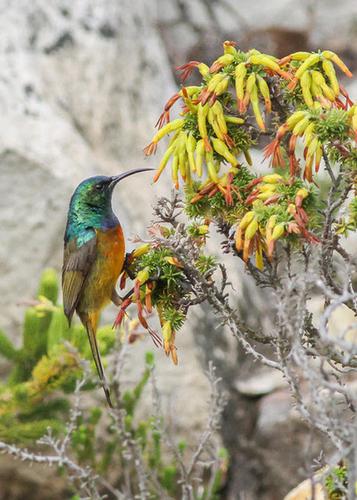当前位置:
X-MOL 学术
›
Funct. Ecol.
›
论文详情
Our official English website, www.x-mol.net, welcomes your
feedback! (Note: you will need to create a separate account there.)
Facilitation and competition shape a geographical mosaic of flower colour polymorphisms
Functional Ecology ( IF 4.6 ) Pub Date : 2021-06-09 , DOI: 10.1111/1365-2435.13851 Anina Coetzee 1 , Colleen L Seymour 1, 2 , Claire N Spottiswoode 3
中文翻译:

促进和竞争形成了花卉颜色多态性的地理马赛克
更新日期:2021-06-09
Functional Ecology ( IF 4.6 ) Pub Date : 2021-06-09 , DOI: 10.1111/1365-2435.13851 Anina Coetzee 1 , Colleen L Seymour 1, 2 , Claire N Spottiswoode 3
Affiliation

|
- Flower colour differs dramatically between populations for some plant species; yet, we know little about what drives this variation. Such polymorphisms can be influenced by plant–pollinator interactions, but whether they are also influenced by pollinator-mediated plant–plant interactions is unknown.
- We test whether flower colour polymorphisms can arise through convergence (facilitation) or divergence (competition) of flower phenotypes resulting from plant–plant interactions mediated by the shared, and only, pollinator (orange-breasted sunbird) of 10 Erica communities in South Africa.
- Sunbird visitation rates to the less-preferred Erica species in communities increased with colour similarity to the most-visited species, suggesting that polymorphisms can be maintained by selection for colour convergence within communities, which promotes shared signals through rewarding mimicry (i.e. facilitation).
- Colour similarity was lowest when risk of reproductive interference was greatest: that is, when reproductive morphology (stigma–anther distance) and flowering phenology was most similar, and when floral density differed greatly between species. This implies that polymorphisms can also be maintained by selection for colour divergence, since this promotes assortative pollinator foraging (i.e. competition).
- Different populations of a species may experience opposite selective pressures, depending on their community context. This is the first evidence that a geographic mosaic of plant–plant pollination interactions could maintain colour polymorphisms in congeneric species sharing a single pollinator.
中文翻译:

促进和竞争形成了花卉颜色多态性的地理马赛克
- 某些植物物种的花色在种群之间存在显着差异;然而,我们对驱动这种变化的原因知之甚少。这种多态性可能会受到植物 - 传粉媒介相互作用的影响,但它们是否也受到传粉媒介介导的植物 - 植物相互作用的影响尚不清楚。
- 我们测试了花颜色多态性是否可以通过花表型的收敛(促进)或发散(竞争)产生,这些表型是由南非10 个埃里卡社区的共享且唯一的传粉媒介(橙胸太阳鸟)介导的植物 - 植物相互作用引起的。
- 太阳鸟对社区中不太受欢迎的 Erica物种的访问率随着与访问量最大的物种的颜色相似性而增加,这表明可以通过选择社区内的颜色收敛来维持多态性,这通过奖励模仿(即促进)促进共享信号。
- 当生殖干扰的风险最大时,颜色相似性最低:即,当生殖形态(柱头-花药距离)和开花物候最相似时,并且当物种之间的花密度差异很大时。这意味着多态性也可以通过颜色发散的选择来维持,因为这促进了多种传粉媒介觅食(即竞争)。
- 一个物种的不同种群可能会经历相反的选择压力,这取决于它们的社区环境。这是植物 - 植物授粉相互作用的地理镶嵌可以维持共享单一授粉媒介的同类物种的颜色多态性的第一个证据。











































 京公网安备 11010802027423号
京公网安备 11010802027423号